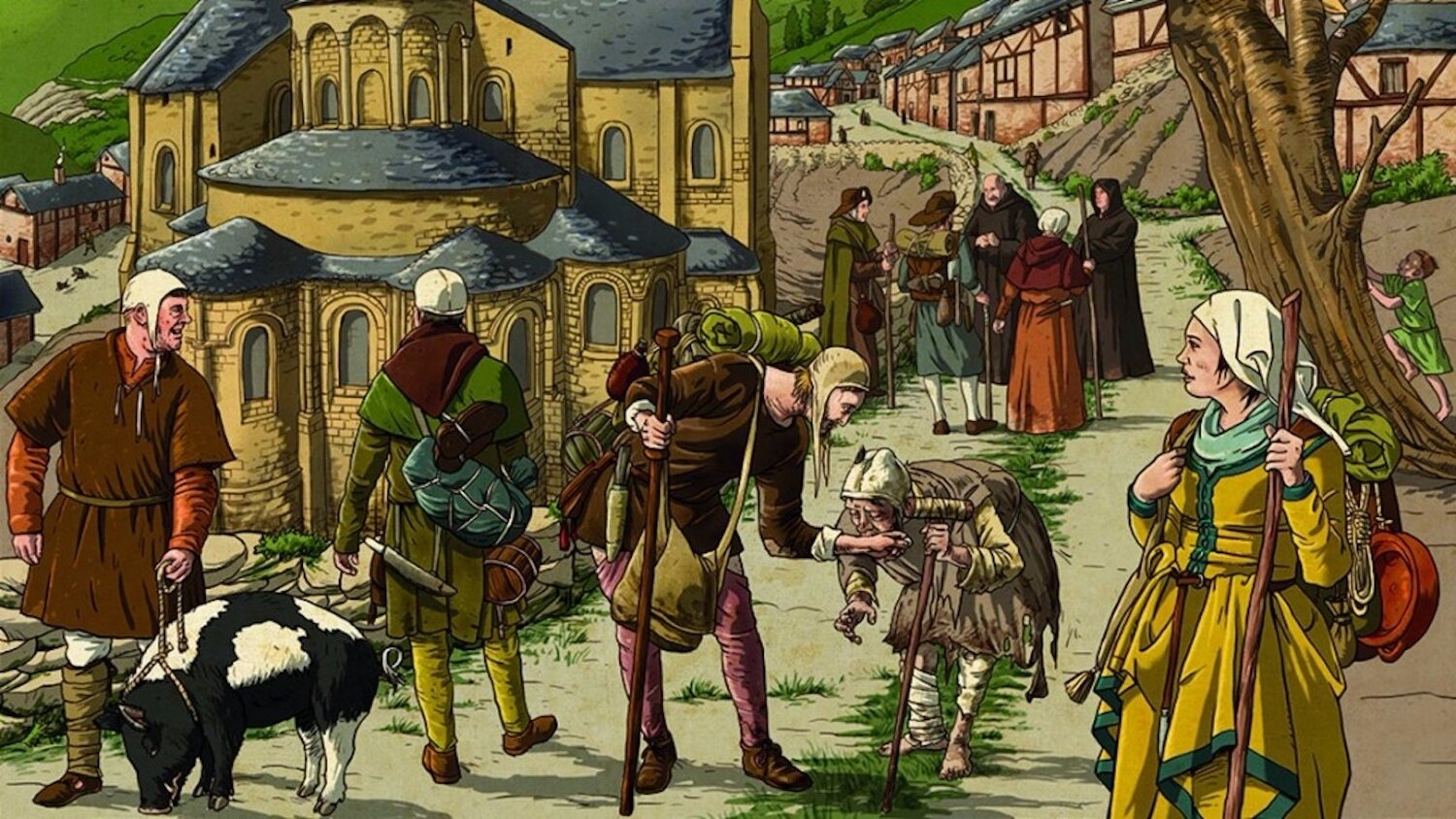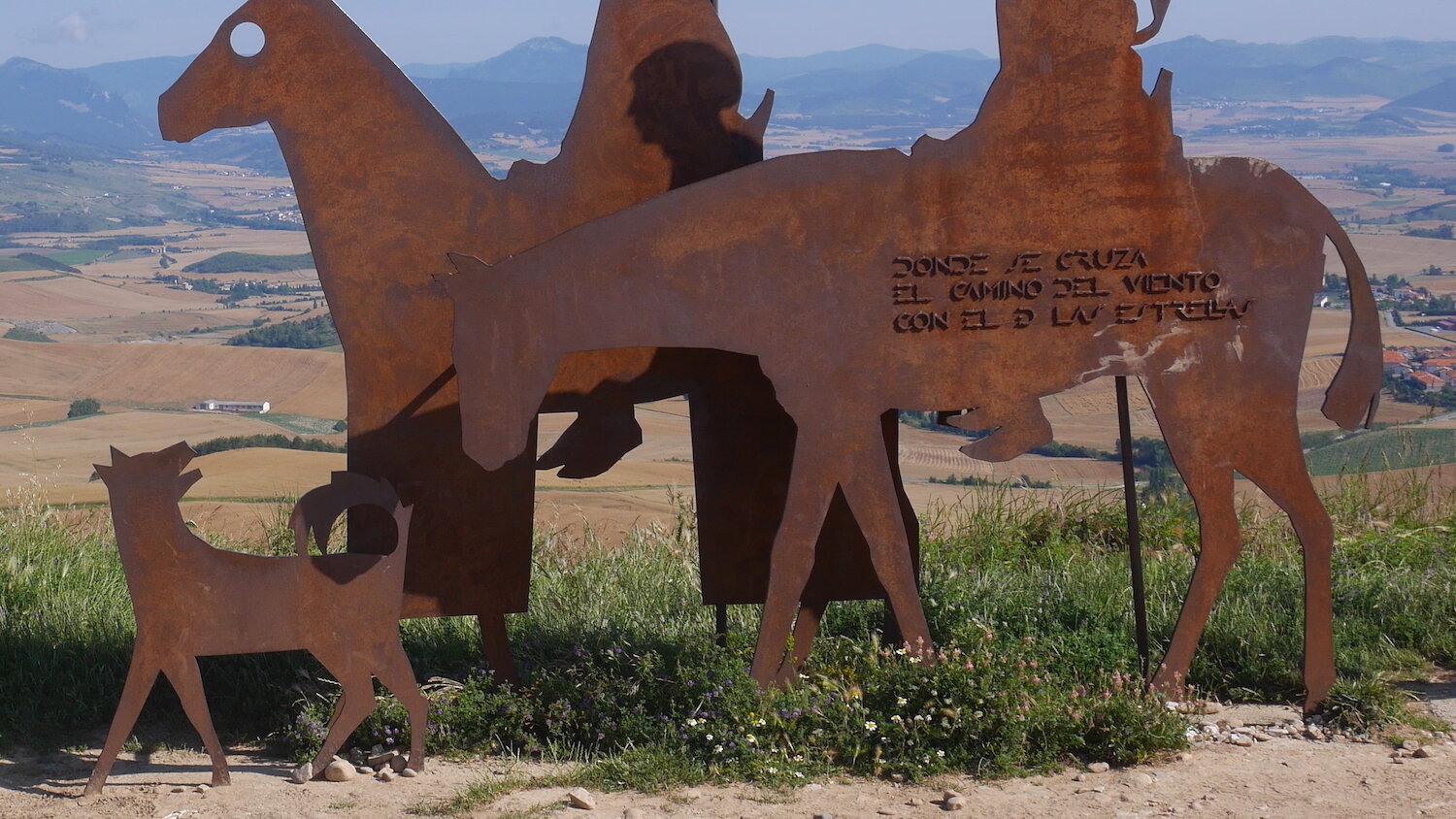The blue-green ridge rose like an island in a cereal sea. A light wind rippled that sea and brushed against my face. Underfoot, the gravel crunched. Powered by vending machine coffee, Bob and I put some distance between ourselves and Pamplona.
The trail between Pamplona and Sierra del Perdón.
The blue-green ridge represented the last wrinkle of the mighty Pyrénées. For west-bound trekkers on the Camino Francés, it is the highest point for the next hundred miles. Possibly the dampest as well. As the Arga River dropped behind us, the trail turned upward. Still higher and above the earth itself, a line of slender Quixotic giants caught and slung Atlantic air.
In addition to these wind turbines, the blue-green ridge carried a name, a promise, and a work of art.
Pamplona environs. Modified image courtesy of Google Earth.
Sierra del Perdón, or simply el Perdón, is the label found on the maps. “Pardon” or “forgiveness” is a regular theme along the path to Santiago de Compostela. Pilgrimage to special places (like Santiago or Jerusalem or Rome) was viewed as an act of devotion or penance for medieval Christians. According to one source, approximately one-fourth of the individuals who walk across Spain claim a spiritual motivation.* Place names such as “high cross” or “hill of joy” are to be expected.
The trail to el Perdón was what we thought it would be: steep, but manageable. As Bob and I ground it out and gained elevation, the toothy Pyrénées gained depth. We kept climbing. Reaching the top in a full sweat, we were congratulated by other hikers, surprised by a limonada stand, and pleased by an iconic piece of artwork.
Our guidebook announced the name of the spot: the Alto del Perdón, roughly, “forgiveness hill” or “ridge.”
It was a good moment for this Protestant perigrino to remember God’s grace.
Perdón, Señor. Forgive me for thinking that I am powered by my own steam.
The view back toward Pamplona and the Arga River Basin.
Beyond a name, the blue-green ridge carried a promise.
The promise of the place comes by way of a 13th century hospital-chapel that used to occupy the site. It is remembered as Nuestra Señora del Perdon,“Our Lady of Forgiveness.” The shelter offered rest to blistered peregrinos, and, according to some, forgiveness in the event of death along the Santiago trail. Bob and I high-fived when we read this tidbit off the sign.
However, what was once a hospital-chapel is now a graveled lot. The hospital-chapel was looted by the French in the Spanish War of Independence and subsequently disappeared.
Perdón, Señor. Forgive me for deeds done and undone.
Illustration of the Camino de Santiago in the Middle Ages. Illustration by Chema Roman. Image from here (accessed 10/14/2021).
Beyond a name and a promise, the blue-green ridge carried a piece of art.
The present-day occupants of Alto del Perdón are made of iron. Silhouettes of pilgrims form a parade line walking in the direction of Santiago de Compostela. Their rusty profiles troop beneath rods that support stars in the sky. The title of the piece suggests this interpretation: Donde se cruza el camino del viento con el de las estrellas, or “where the path of the wind crosses with that of the stars.”
This work by artist Vincent Galbete was erected in 1996. Since that time, it has become an iconic image of the Camino experience.
Galbete intentionally arranged his figures in a way that tracks the development of the historic pilgrimage. The last hikers in the lineup wear backpacks and sunhats.
The parade of figures.
The art is a timely reminder that our journey does not begin or end in isolation. We are all a part of a march that is connected with the past and with the future. We have the freedom to make many choices, but our context is chosen for us.
Perdón, Señor. Forgive me when I forget those around me.
Bob and I took the obligatory photos, enjoyed the wonderful view, and ate the snacks we carried. Satisfied, we rejoined the trail and descended the other side of the blue-green ridge.
¡Buen Camino!
The title of the work appears on the side of one of the horses: “Where the path of the wind crosses with that of the stars.” I liked the dog.
*This statistic comes from the post here (accessed 10/14/2021). Other people walk the Camino for exercise, adventure, disconnection from everyday life, and for fun. My motivation would include all of the above, but would add the category of “historical exercise” to the list.
With travel restrictions easing, we have a full slate of trips to the Bible Lands ready to launch in 2022. One departs New York for Israel on March 12 and returns on March 25. This high-energy study tour will move light and fast, so pack your hiking shoes! Walt Harper, professor from Central Christian College of the Bible and Jeff Snell from Johnson University will assist with teaching duties on this one. For more information click here or contact me at markziese@gmail.com.






